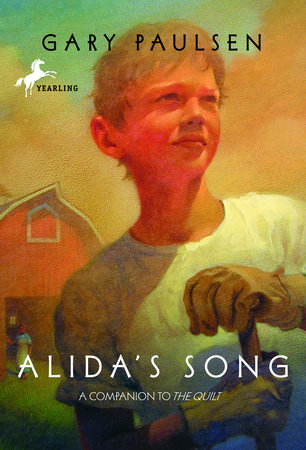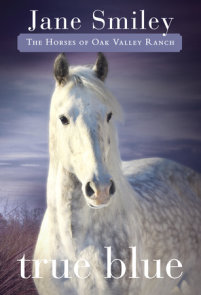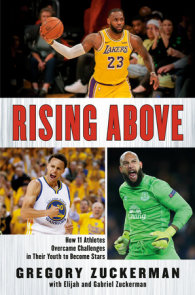TEACHING GUIDE
ABOUT THIS BOOK
Life with a boy’s loving grandmother gives him strenght and faith in himself, drawing him away from the edge and into the center of life, in these two remarkable novels based on one of the most important relationships in Gary Paulsen’s life.
In The Cookcamp, it’s 1944 and a 5-year-old boy’s mother works in a factory while his father is away at war. Soon the boy is sent to stay with his grandmother, who cooks for a work crew building a road from Minnesota to Canada. Although living in the forest is a great adventure, the little boy misses his mother. His grandmother teachers him about love and friendship–something his mother is unable to do–and also helps him find a way to return home.
The boy is now 14 in Alida’s Song. A failure at school, and painfully shy, the boy is facing another ordinary summer working at odd jobs for extra money when he receives a letter from his grandmother Alida inviting him to take a job at the farm where she works. Once again, Alida realizes that his life is in trouble and only she can help him find himself and begin his journey toward becoming a man.
ABOUT THIS AUTHOR
Three-time Newbery Honor winner Gary Paulsen developed a passion for reading at an early age. Running away from home at the age of 14 and traveling with with a carnival, Paulsen acquired a taste for adventure. His realization that he would become a writer came suddenly when he was working as a satellite technican for an aerospace firm in California. One night he walked off the job, and spent the next year in Hollywood as a magazine proofreader, working on his own writing every night. He completed his first novel later that year.
TEACHING IDEAS
PRE-READING ACTIVITY
Ask students to bring a picture of one of their grandparents or another important adult to class. Encourage them to share a story about a special time spent with that person. Then have them write an appropriate caption for the photograph and place it on a bulletin board in the classroom.
THEMATIC CONNECTIONS
SURVIVAL–How might The Cookcamp and Alida’s Song be considered survival novels? What is the boy’s greatest challenge? Discuss what the boy learns from his grandmother about survival.
INTERGENERATIONAL RELATIONSHIPS–How does Alida’s intuition guide her to know that the boy needs her help? In The Cookcamp, she tells him “I’m here…I’ll always be here” (p. 25). Discuss how Alida always seems to reappear in his life just when he needs her most? What does he learn from Alida during the summer of his 14th year? At what point does he learn that his grandmother in the most important person in his life?
LONELINESS–The boy is a lonely 5-year-old in The Cookcamp. His loneliness has grown more severe by the time he reaches junior high school in Alida’s Song. Discuss the classic symptoms of loneliness. Have students compare and contrast how the boy deals with his loneliness at age 5 to how he deals with it at age 14.
FAMILY–Discuss the boy’s relationship with his mother in The Cookcamp and with both his parents in Alida’s Song. Why is his mother so eager to send her 5-year-old son to his grandmother? How do the boy’s parent’s contribute to his loneliness and shyness?
In The Cookcamp, the boy “had an intense feeling of missing something and he did not know even what it was…”(p. 110). Discuss what the boy is missing. Does he find it in Alida’s Song?
GROWING UP–The boy spends nights with the road builders, and feels “the edges of being a man” (The Cookcamp, p. 93). What are the qualities of manhood? When does he begin putting together all of its pieces? Divide the class into small groups. Have each group draw an outline of the boy on a sheet of paper and cut the drawing into puzzle pieces. Instruct them to connect the edges, then fill in the pieces as the boy learns about being a man, writing what the boy learns on each piece. Display the puzzles and discuss the boy’s growth.
CONNECTING TO THE CURRICULUM
LANGUAGE ARTS–The boy’s grandmother is angered when she finds out about his mother’s friend whom he calls Uncle Casey. Write the letter that Alida might have written to the boy’s mother on the day he tells her about Uncle Casey. What does Alida mean when she tells the store clerk to mail the letters “good and hard” (The Cookcamp, p. 84)?
The Cookcamp and Alida’s Song are written in the third, and the boy is never called by name. Why do you think Paulsen chose not to name the boy? Ask students to select a short chapter from either novel and rewrite it in the first person from the boy’s point of view.
SOCIAL STUDIES–The Cookcamp is set during World War II. The boy’s mother works in a factory because so many men are away fighting; the men building the road in Norther Minnesota are too old to go to war. Divide the class into two groups. Ask one group to research the jobs that woman did to help the war effort; have the other find out jobs that employed men unable to fight.
In Alida’s Song, the boy works for the summer on Nelson farm. There are fields of oats, barley, wheat, and corn. Ask students to use an encyclopedia, world almanac, or the Internet to find out how much farmland is in Minnesota today. What are the primary crops?
SCIENCE/HEALTH–Harvey, one of the road builders in the The Cookcamp, goes into shock when a tree falls on him. Ask students to find out the treatment for shock. Then have them make a list of supplies that should be included in a first aid kit.
In Alida’s Song, geese attack the boy. His grandmother explains that geese have triggers in their wings. Ask students to think of other animals that the may encounter on the farm. Have them find out how these animals defend themselves.
MATH–In Alida’s Song, the boy sells newspapers. He usually sells 40 newspapers a day, making a nickel a paper in commission. Ask students to find out how much commission a person can make selling newspapers today. Calculate how much a person can make in a week if they sel 40 newspapers a day.
MUSIC–Alida is from Norway and often sings Norweigan folk songs as she works. Edvard Hagerup Grieg, a distinguished Norweigan composer of the 19th century, based many of his compositions on Norweigan folk music. Play recordings of Grieg’s music for the students. Ask them to describe the folk music qualities.
ART–In The Cookcamp, the grandmother gives the boy a thimble that has been in her family for generations. She tells the boy that the figure decorating the thimble reminds her of him. Ask students to select one character from the book and decorate a wooden thimble to resemble that character.
VOCABULARY
Ask students to search for unfamiliar words and try to define them from the context of the story. Words in The Cookcamp may include snose (p. 27), mimic (p. 40), lilting (p. 76), and placard (p.111).
Words in Alida’s Song may include solemnity (p. 9), foundered (p. 46), and fiends (p. 53).
OTHER TITLES OF INTEREST
Coast to Coast
Besty Byars
Intergenerational Relationships • Family
Grades 4-6 / 0-440-40926-8
Journey
Patricia MacLachlan
Intergenerational Relationships • Family • Loneliness
Grades 4-7 / 0-440-40809-1
Lily’s Crossing
Patricia Reilly Giff
Intergenerational Relationships • Family • Loneliness
Grades 4-7 / 0-440-41453-9
COPYRIGHT
Prepared by Pat Scales, Director of Library Services, the South Carolina Governor’s School for the Arts and Humanities, Greenville.
×
Become a Member
Just for joining you’ll get personalized recommendations on your dashboard daily and features only for members.
Find Out More Join Now Sign In



















